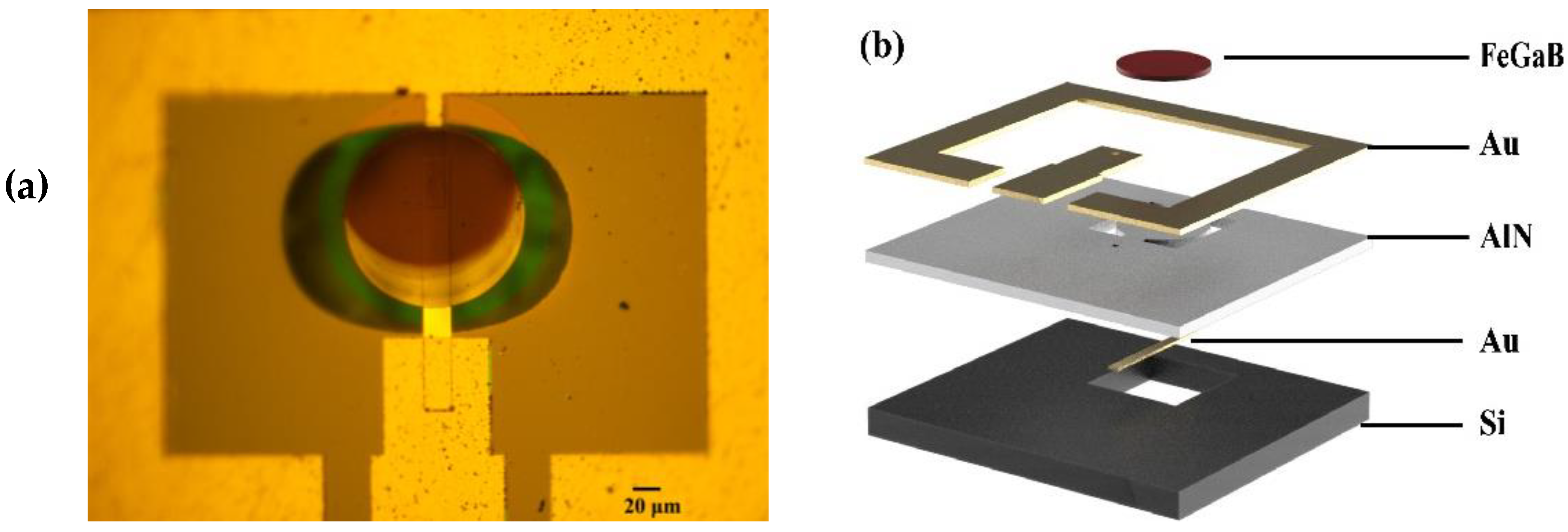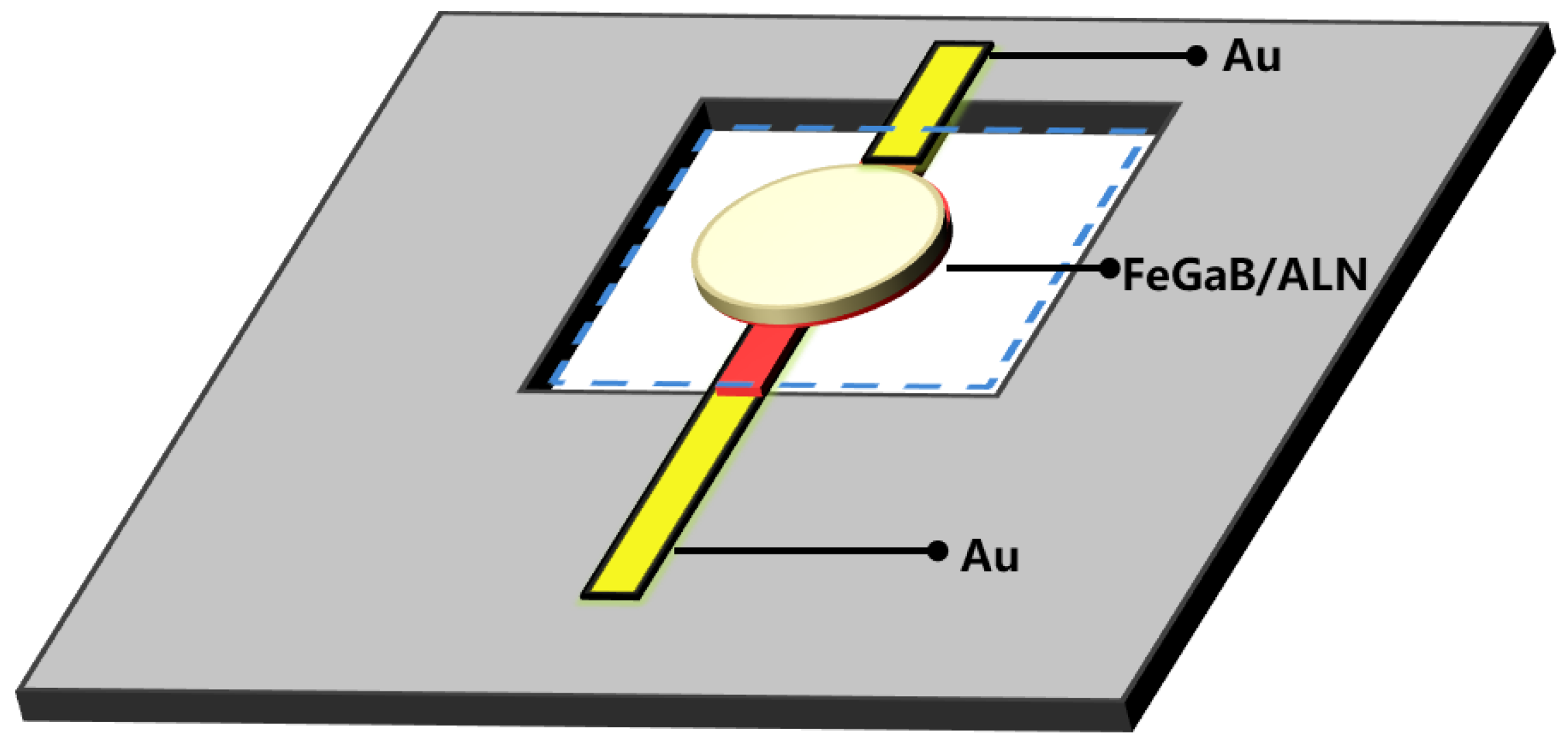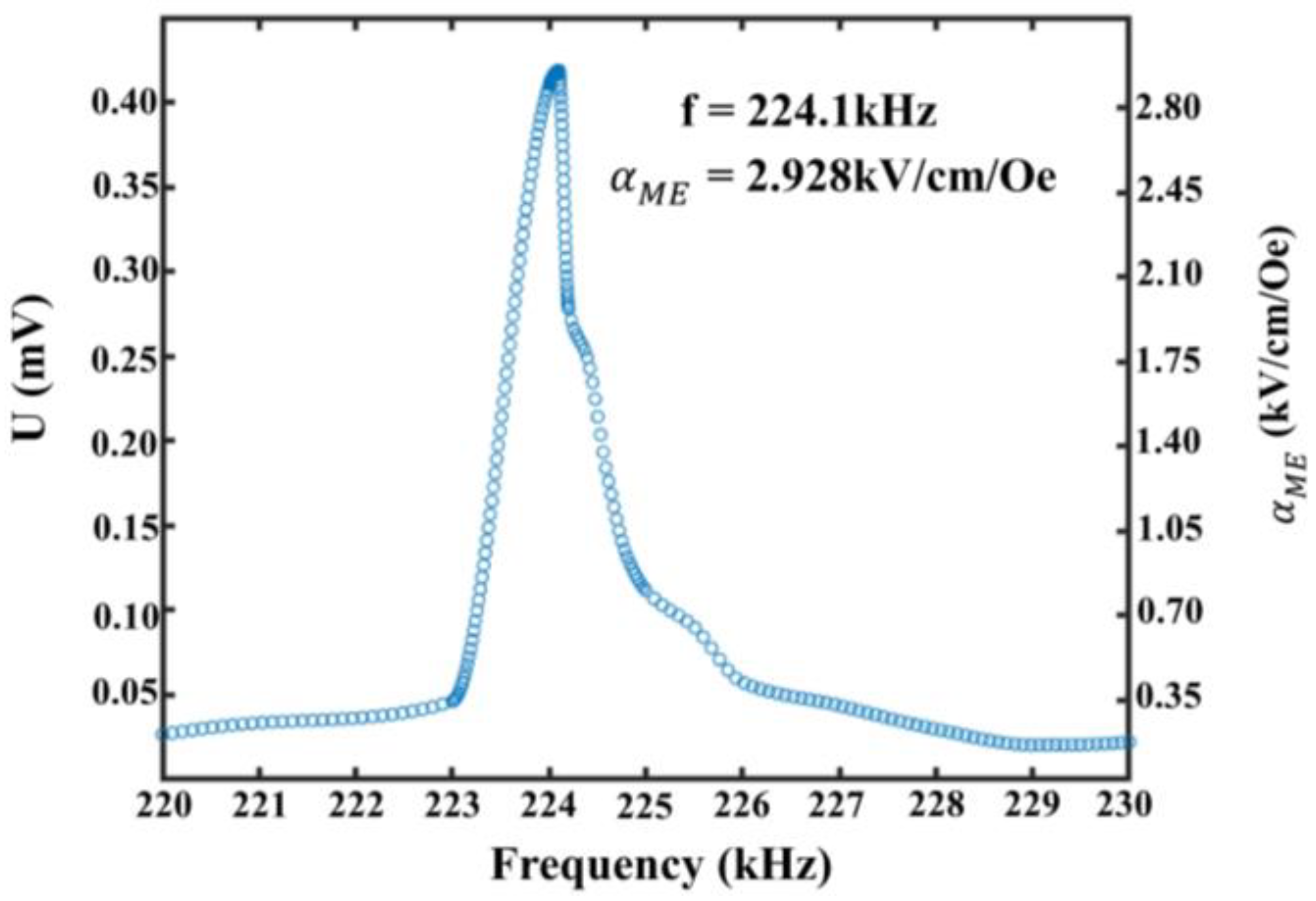A Low-Frequency MEMS Magnetoelectric Antenna Based on Mechanical Resonance
Abstract
:1. Introduction
2. Materials and Methods
2.1. MEMS Magnetoelectric Antenna Concepts
2.2. MEMS Magnetoelectric Antenna Sample Fabrication
2.3. Measurement Setup
- (1)
- Place the MEMS magnetoelectric antenna chip in the magnetic constant position of the Helmholtz coil after cleaning, with the electromagnetic field vertical to the MEMS magnetoelectric antenna.
- (2)
- Gradually decrease the current strength of the input Helmholtz coil in suitable steps, and record and analyze the output signal.
- (3)
- Collect the vacant wire data of channel 2, compare with the test data, and exclude the wire and chance errors.
3. Results
3.1. Signal Analysis and Processing
3.2. Sensitivity and Detection Limit
4. Conclusions
Author Contributions
Funding
Acknowledgments
Conflicts of Interest
References
- Kramer, B.A.; Chen, C.; Lee, M.; Volakis, J.L. Fundamental Limits and Design Guidelines for Miniaturizing Ultra-Wideband Antennas. IEEE Antennas Propag. Mag. 2009, 51, 57–69. [Google Scholar] [CrossRef]
- Chang, S.H.; Liao, W.J. A Broadband LTE/WWAN Antenna Design for Tablet PC. IEEE Trans. Antennas Propag. 2012, 60, 4354–4359. [Google Scholar] [CrossRef]
- Liu, H.; Ishikawa, S.; An, A.; Kurachi, S.; Yoshimasu, T. Miniaturized microstrip meander-line antenna with very high-permittivity substrate for sensor applications. Microw. Opt. Technol. Lett. 2010, 49, 2438–2440. [Google Scholar] [CrossRef]
- Medeiros, C.R.; Costa, J.R.; Fernandes, C.A. RFID Reader Antennas for Tag Detection in Self-Confined Volumes at UHF. IEEE Antennas Propag. Mag. 2011, 53, 39–50. [Google Scholar] [CrossRef] [Green Version]
- Ouedraogo, R.O.; Rothwell, E.J.; Diaz, A.R.; Fuchi, K.; Temme, A. Miniaturization of Patch Antennas Using a Metamaterial-Inspired Technique. IEEE Trans. Antennas Propag. 2012, 60, 2175–2182. [Google Scholar] [CrossRef]
- Gianvittorio, J.P.; Rahmat-Samii, Y. Fractal antennas: A novel antenna miniaturization technique, and applications. IEEE Antennas Propag. Mag. 2002, 44, 20–36. [Google Scholar] [CrossRef]
- Wang, Z.; Zhang, L.; Bayram, Y.; Volakis, J.L. Embroidered Conductive Fibers on Polymer Composite for Conformal Antennas. IEEE Trans. Antennas Propag. 2012, 60, 4141–4147. [Google Scholar] [CrossRef]
- Volakis, J.L.; Sertel, K. Narrowband and Wideband Metamaterial Antennas Based on Degenerate Band Edge and Magnetic Photonic Crystals. Proc. IEEE 2011, 99, 1732–1745. [Google Scholar] [CrossRef]
- Bickford, J.A.; Duwel, A.E.; Weinberg, M.S.; McNabb, R.S.; Freeman, D.K.; Ward, P.A. Performance of Electrically Small Conventional and Mechanical Antennas. IEEE Trans. Antennas Propag. 2019, 67, 2209–2223. [Google Scholar] [CrossRef]
- Xu, G.; Xiao, S.; Li, Y.; Wang, B.Z. Modeling of electromagnetic radiation-induced from a magnetostrictive/piezoelectric laminated composite. Phys. Lett. A 2021, 385, 126959. [Google Scholar] [CrossRef]
- Kemp, M.A.; Franzi, M.; Haase, A.; Jongewaard, E.; Whittaker, M.T.; Kirkpatrick, M.; Sparr, R. A high Q piezoelectric resonator as a portable VLF transmitter. Nat. Commun. 2019, 10, 1715. [Google Scholar] [CrossRef] [PubMed] [Green Version]
- Dong, C.; He, Y.; Li, M.; Tu, C.; Chu, Z.; Liang, X.; Chen, H.; Wei, Y.; Zaeimbashi, M.; Wang, X.; et al. A Portable Very Low Frequency (VLF) Communication System Based on Acoustically Actuated Magnetoelectric Antennas. IEEE Antennas Wirel. Propag. Lett. 2020, 19, 398–402. [Google Scholar] [CrossRef]
- Nan, T.; Lin, H.; Gao, Y.; Matyushov, A.; Yu, G.; Chen, H.; Sun, N.; Wei, S.; Wang, Z.; Li, M.; et al. Acoustically actuated ultra-compact NEMS magnetoelectric antennas. Nat. Commun. 2017, 8, 296. [Google Scholar] [CrossRef] [PubMed]
- Liang, X.; Dong, C.; Chen, H.; Wang, J.; Wei, Y.; Zaeimbashi, M.; He, Y.; Matyushov, A.; Sun, C.; Sun, N. A Review of Thin-Film Magnetoelastic Materials for Magnetoelectric Applications. Sensors 2020, 20, 1532. [Google Scholar] [CrossRef] [Green Version]
- Stadler, B.; Reddy, M.; Basantkumar, R.; McGary, P.; Estrine, E.; Huang, X.; Sung, S.Y.; Tan, L.; Zou, J.; Maqableh, M.; et al. Galfenol Thin Films and Nanowires. Sensors 2018, 18, 2643. [Google Scholar] [CrossRef] [Green Version]
- Schmidt, R.; Graf, A.; Decker, R.; Heinrich, M.; Kräusel, V.; Kroll, L.; Hardt, W. Monitoring the Structural Health of Glass Fibre-Reinforced Hybrid Laminates Using Novel Piezoceramic Film. Sensors 2020, 20, 5428. [Google Scholar] [CrossRef]
- Reis, S.; Silva, M.P.; Castro, N.; Correia, V.; Rocha, J.G.; Martins, P.; Lasheras, A.; Gutierrez, J.; Lanceros-Mendez, S. Electronic optimization for an energy harvesting system based on magnetoelectric Metglas/poly (vinylidene fluoride)/Metglas composites. Smart Mater. Struct. 2016, 25, 085028. [Google Scholar] [CrossRef]
- Palneedi, H.; Annapureddy, V.; Priya, S.; Ryu, J. Status and Perspectives of Multiferroic Magnetoelectric Composite Materials and Applications. Actuators 2016, 5, 9. [Google Scholar] [CrossRef] [Green Version]
- Finkel, P.; Pérez Moyet, R.; Wun-Fogle, M.; Restorff, J.; Kosior, J.; Staruch, M.; Stace, J.; Amin, A. Non-Resonant Magnetoelectric Energy Harvesting Utilizing Phase Transformation in Relaxor Ferroelectric Single Crystals. Actuators 2015, 5, 2. [Google Scholar] [CrossRef]
- Yu, G.; Lin, H.; Li, Y.; Zhang, H.; Sun, N. Voltage-Driven 180° Magnetization Switching in Magnetoelectric Heterostructures. IEEE Trans. Magn. 2017, 53, 1–5. [Google Scholar] [CrossRef]
- Ren, W.; Li, J.; Liu, G.; Chen, J. Design and Optimization of a BAW Magnetic Sensor Based on Magnetoelectric Coupling. Micromachines 2022, 13, 206. [Google Scholar] [CrossRef] [PubMed]
- Marauska, S.; Jahns, R.; Kirchhof, C.; Claus, M.; Quandt, E.; Knöchel, R.; Wagner, B. Highly sensitive wafer-level packaged MEMS magnetic field sensor based on magnetoelectric composites. Sens. Actuators A Phys. 2013, 189, 321–327. [Google Scholar] [CrossRef]
- Su, J.; Niekiel, F.; Fichtner, S.; Kirchhof, C.; Meyners, D.; Quandt, E.; Wagner, B.; Lofink, F. Frequency tunable resonant magnetoelectric sensors for the detection of weak magnetic field. J. Micromech. Microeng. 2020, 30, 075009. [Google Scholar] [CrossRef]
- Yao, Z.; Wang, Y.E.; Keller, S.; Carman, G.P. Bulk Acoustic Wave-Mediated Multiferroic Antennas: Architecture and Performance Bound. IEEE Trans. Antennas Propag. 2015, 63, 3335–3344. [Google Scholar] [CrossRef]
- Chen, S.; Li, J.; Gao, Y.; Li, J.; Dong, H.; Gu, Z.; Ren, W. Micromechanical Transmitter with Only One BAW Magneto-Electric Antenna. Micromachines 2022, 13, 272. [Google Scholar] [CrossRef]
- Zaeimbashi, M.; Nasrollahpour, M.; Khalifa, A.; Romano, A.; Liang, X.; Chen, H.; Sun, N.; Matyushov, A.; Lin, H.; Dong, C.; et al. Ultra-compact dual-band smart NEMS magnetoelectric antennas for simultaneous wireless energy harvesting and magnetic field sensing. Nat. Commun. 2021, 12, 3141. [Google Scholar] [CrossRef]
- Das, D.; Nasrollahpour, M.; Xu, Z.; Zaeimbashi, M.; Onabajo, M. A radio frequency magnetoelectric antenna prototyping platform for neural activity monitoring devices with sensing and energy harvesting capabilities. Electronics 2020, 9, 2123. [Google Scholar] [CrossRef]
- Shackelford, J.F.; Alexander, W. (Eds.) CRC Materials Science and Engineering Handbook, 3rd ed.; Chemical Engineering; CRC Press: Boca Raton, FL, USA, 2000; p. 41. [Google Scholar]
- Salvadori, M.C.; Vaz, A.R.; Melo, L.L.; Cattani, M. Nanostructured gold thin films: Young modulus measurement. Surf. Rev. Lett 2003, 10, 571–575. [Google Scholar] [CrossRef]
- Marauska, S.; Jahns, R.; Greve, H.; Quandt, E.; Knöchel, R.; Wagner, B. MEMS magnetic field sensor based on magnetoelectric composites. J. Micromech. Microeng. 2012, 22, 065024. [Google Scholar] [CrossRef]







Publisher’s Note: MDPI stays neutral with regard to jurisdictional claims in published maps and institutional affiliations. |
© 2022 by the authors. Licensee MDPI, Basel, Switzerland. This article is an open access article distributed under the terms and conditions of the Creative Commons Attribution (CC BY) license (https://creativecommons.org/licenses/by/4.0/).
Share and Cite
Wang, Y.; Ma, Z.; Fu, G.; Wang, J.; Xi, Q.; Wang, Y.; Jia, Z.; Zi, G. A Low-Frequency MEMS Magnetoelectric Antenna Based on Mechanical Resonance. Micromachines 2022, 13, 864. https://doi.org/10.3390/mi13060864
Wang Y, Ma Z, Fu G, Wang J, Xi Q, Wang Y, Jia Z, Zi G. A Low-Frequency MEMS Magnetoelectric Antenna Based on Mechanical Resonance. Micromachines. 2022; 13(6):864. https://doi.org/10.3390/mi13060864
Chicago/Turabian StyleWang, Yinan, Zhibo Ma, Guanglei Fu, Jiayan Wang, Qi Xi, Yuanhang Wang, Ziqiang Jia, and Guhao Zi. 2022. "A Low-Frequency MEMS Magnetoelectric Antenna Based on Mechanical Resonance" Micromachines 13, no. 6: 864. https://doi.org/10.3390/mi13060864
APA StyleWang, Y., Ma, Z., Fu, G., Wang, J., Xi, Q., Wang, Y., Jia, Z., & Zi, G. (2022). A Low-Frequency MEMS Magnetoelectric Antenna Based on Mechanical Resonance. Micromachines, 13(6), 864. https://doi.org/10.3390/mi13060864





